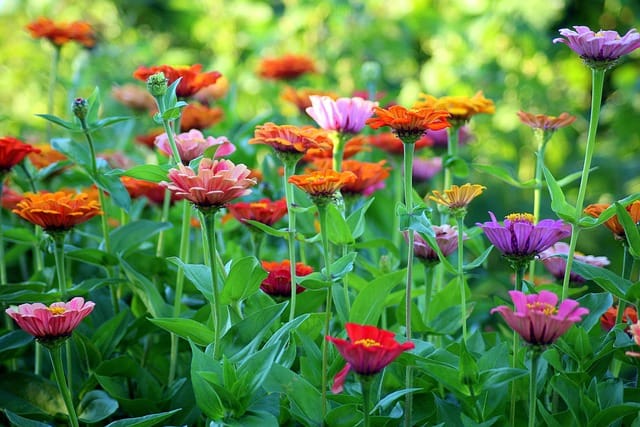How to grow Zinnias
Zinnias are beautiful and colorful annual flowers that can add vibrancy to any garden

In this article:
- Introduction
- Choosing the Right Zinnias Variety
- Preparing the Soil for Zinnias
- Planting Zinnias Seeds
- Caring for Zinnias Seedlings
- Transplanting Zinnias
- Watering and Fertilizing Zinnias
- Managing Pests and Diseases in Zinnias
- Pruning and Deadheading Zinnias
- Extending the Zinnias Blooming Period
- Harvesting Zinnias Seeds
- Overwintering Zinnias
- Frequently Asked Questions about Growing Zinnias
- Conclusion
Introduction
Zinnias are beautiful and colorful annual flowers that can add vibrancy to any garden. They are easy to grow and come in a variety of shapes, sizes, and colors. Whether you are a beginner or an experienced gardener, learning how to grow Zinnias can be a rewarding experience. This article will guide you through the process of growing Zinnias from seed to bloom.
Choosing the Right Zinnias Variety
There are many different varieties of Zinnias to choose from, each with its own unique characteristics. When selecting a variety, consider factors such as height, bloom size, color, and disease resistance. Some popular Zinnias varieties include California Giants, Profusion series, and Thumbelina.
Preparing the Soil for Zinnias
Zinnias thrive in well-draining soil with a pH between 5.5 and 7.5. Before planting your Zinnias, prepare the soil by removing any weeds or debris. Loosen the soil and amend it with compost or aged manure to improve its fertility and drainage.
Planting Zinnias Seeds
Zinnias can be directly sown outdoors after the last frost date in your area. Alternatively, you can start seeds indoors 4-6 weeks before the last frost date and then transplant the seedlings outdoors. Sow the seeds at a depth of ¼ inch and space them according to the instructions on the seed packet.
Caring for Zinnias Seedlings
Keep the soil consistently moist but not waterlogged until the seeds germinate. Once the seedlings emerge, thin them to maintain a distance of 6-18 inches between plants, depending on the variety. Provide them with plenty of sunlight, at least 6 hours per day, and protect them from strong winds.
Transplanting Zinnias
If you started your Zinnias indoors, transplant them outdoors once the danger of frost has passed and the seedlings have developed 2-3 sets of true leaves. Choose a location that receives full sun and has well-draining soil. Space the transplants according to the instructions on the seed packet.
Watering and Fertilizing Zinnias
Water your Zinnias deeply and consistently, keeping the soil moist but not soaked. Avoid overhead watering to prevent the spread of diseases. Fertilize the plants every 4-6 weeks with a balanced liquid fertilizer or a slow-release granular fertilizer according to the package instructions.
Managing Pests and Diseases in Zinnias
Zinnias are generally resistant to pests and diseases. However, they can sometimes be affected by aphids, Japanese beetles, powdery mildew, or leaf spot. Monitor your plants regularly and take appropriate measures such as handpicking pests or applying organic insecticides and fungicides as needed.
Pruning and Deadheading Zinnias
To promote bushier growth and a longer blooming period, pinch back the tips of your Zinnias when they are about 6 inches tall. Deadhead faded flowers regularly to encourage continuous blooming. Cut the flower stem just above the first set of leaves to prevent seed formation and redirect the plant's energy towards producing new blooms.
Extending the Zinnias Blooming Period
You can extend the blooming period of your Zinnias by regularly removing faded flowers, providing proper nutrition through regular fertilization, and ensuring consistent watering. Additionally, you can plant a mix of early, mid, and late-blooming Zinnias varieties to enjoy a prolonged display of vibrant colors in your garden.
Harvesting Zinnias Seeds
If you want to save Zinnias seeds for future planting, allow some flowers to fully mature on the plants. The petals will dry and fall off, revealing seed heads. Collect the seed heads and store them in a cool, dry place until you are ready to plant them again.
Overwintering Zinnias
Zinnias are annual flowers, which means they complete their life cycle in one season. However, if you live in a warm climate with mild winters, you can try overwintering Zinnias by cutting them back to a few inches above the ground after they finish blooming and providing them with a protective mulch layer. With proper care, they may survive and bloom again in the following season.
Frequently Asked Questions about Growing Zinnias
Q: How long do Zinnias take to bloom?
A: Zinnias typically start blooming 6-8 weeks after sowing the seeds.
Q: Do Zinnias attract pollinators?
A: Yes, Zinnias are excellent nectar sources and attract pollinators such as bees and butterflies to your garden.
Q: Can I grow Zinnias in containers?
A: Yes, Zinnias can be grown in containers as long as they have enough space for their roots to grow and receive adequate sunlight and water.
Conclusion
By following the steps outlined in this article, you can successfully grow Zinnias and enjoy their vibrant blooms throughout the summer. Remember to choose the right variety, prepare the soil properly, provide adequate care, and manage pests and diseases as needed. With a little effort and patience, you'll have a stunning display of Zinnias in your garden.
